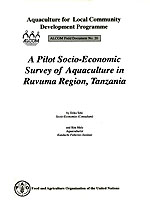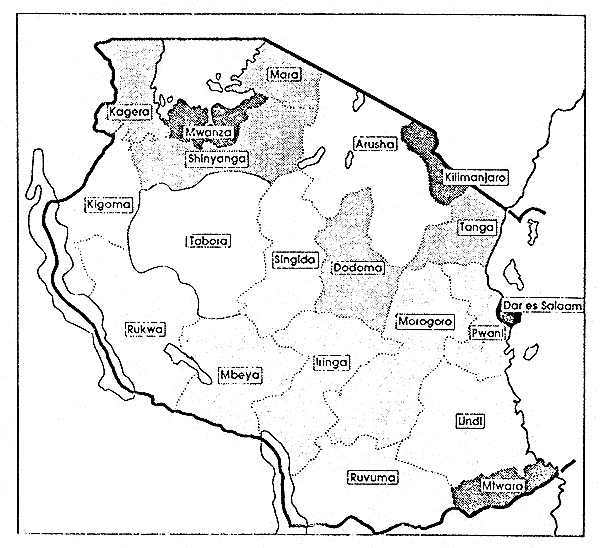
of Aquaculture in
Ruvuma Region, Tanzania
| ALCOM | GCP/INT/555/SWE |
| Aquaculture for Local Community Development Programme | GCP/RAF/273/JPN |
ALCOM Field Document No. 20
 | A Pilot Socio-Economic Survey of Aquaculture in Ruvuma Region, Tanzania |
| TABLE OF CONTENTS |
by
Erika Seki
Socio-Economist, Consultant
and
Rita Maly
Aquaculturist
Kunduchi Fisheries Institute, Tanzania
Funding Agencies:
SWEDISH INTERNATIONAL DEVELOPMENT AUTHORITY
JAPAN INTERNATIONAL COOPERATION AGENCY
Executing Agency:
FOOD AND AGRICULTURE ORGANIZATION OF THE UNITED NATIONS
Harare, Zimbabwe, October 1993
Hyperlinks to non-FAO Internet sites do not imply any official endorsement of or responsibility for the opinions, ideas, data or products presented at these locations, or guarantee the validity of the information provided. The sole purpose of links to non-FAO sites is to indicate further information available on related topics.
This electronic document has been scanned using optical character recognition (OCR) software. FAO declines all responsibility for any discrepancies that may exist between the present document and its original printed version.
2.6 Organization of the survey
3. GENERAL PICTURE OF FISH FARMING IN RUVUMA REGION: RESULTS OF FORM I
3.1 Brief description of survey area
3.2 Characteristics of Fish Farming Unit (FFU)
3.2.1 Number of FFU
3.2.2 Number of ponds per FFU
3.2.3 Types of FFUs
3.2.4 Characteristics of the owners
3.3.1 Number of operating and non operating ponds
3.3.2 Ponds specifications; size, depth, drainage
3.3.3 Source of water
3.3.4 Stocking
3.3.5 Feeding, fertilizing and harvesting
3.3.6 Sources of information
4. MORE DETAILED CHARACTERISTICS OF FISH FARMING: THE RESULTS OF FORM II
4.2.1 Types of fertilizer used
4.2.2 Types of feed
4.2.3 Frequency of feeding
4.3.1 Intermittent harvest
4.3.2 Batch harvest
4.5 Frequency of fish consumption
4.6 Importance of fish farming to the households
4.6.1 Households, sources of income
4.6.2 Use of income from fish farming
4.6.3 Reasons for fish farming
4.7 Socio-economic characteristics of FFHs and Non-FFHs
4.7.1 Agriculture holdings
4.7.2 Livestock holdings
5. FISH FARMING FROM THE STANDPOINT OF WOMEN
5.1 Division of labour and decision-making in fish farming households
5.2 Access and control over resources and benefits
5.3 Non-fish farming households (FFHs)
6. CONCLUSIONS AND RECOMMENDATIONS
6.1 Recommendations for Ruvuma region
6.2 Evaluation of the survey method
TABLES
1 Summary results of 1990/91 pond census
2 Summary of survey enumeration
3 Fish farming standards in Ruvuma region
4 Number of fish farming units in Ruvuma region
5 Types of pond ownership
6 Sex of pond owners
7 Main occupation of pond owners
8 Number of ponds
9 Average size of fish ponds
10 Species stocked
11 Sources of fingerlings
12 Characteristics of pond management
13 Sources of information about fish farming
14 Types of land ownership for ponds
15 Types of labour used to construct ponds
16 Types of fertilizer used by FFUs
17 Types of feed used by FFUs
18 Frequency of feeding by FFUs
19 Frequency of intermittent harvesting
20 Production of last intermittent harvest
21 Number of months between stocking and batch harvest
22 Method for batch harvesting
23 Quantity of fish from last batch harvest
24 Quantity and value of fish sold during the last
batch harvest (1991/1992 price)
25 Value of fish (1991/1992 price)
26 Average stocking density
27 Estimate of production
28 Comparison of gross revenue from fish farming, maize,
tobacco and coffee cultivations
29 Sales of fingerlings by FFUs
30 Indicative costs and earnings of aquaculture in
Ruvuma region
31 Agricultural land holding of fish farming households
32 Average agricultural holding of fish farming households
33 Average livestock holding of fish farming households
34 Summary of organization of informal interviews
FIGURES
1 Number of ponds per fish farming unit
2 Sources of water
3 Year of first stocking
4 Interval between stocking and first intermittent harvest
5 Number of months between stocking and batch harvest
6 Distribution of production by batch harvest
7 Frequency of consumption of fish from ponds and other
animal protein food
8 Sources of income of fish farming households
9 Uses of income from fish farming
10 Reasons for fish farming
ANNEXURES
I Questionnaires
II Key informant interview schedule 1: General
Key informant interview schedule 2: fish farming extension
Key informant interview schedule 3: fish farming households
Key informant interview schedule 4: non-fish farming households
III Organization of the survey team
IV Characteristics of the enumeration area
V Agro ecological zones in Ruvuma region
VI Tables
VII Project proposal :1
Project proposal :2
VIII General overview of aquaculture in Ruvuma region: report of preparatory workshop in Songea
IX Data processing programme
This report was prepared during the course of the project identified on the title page. The conclusions and recommendations given in the report are those considered appropriate at the time of its preparation. They may be modified in the light of the further knowledge gained at subsequent stages of the project.
The designations employed and the presentation of the material in this document do not imply the expression of any opinion whatsoever on the part of the United Nations or the Food and Agriculture Organization of the United Nations concerning the legal or constitutional status of any country, territory or sea area, or concering the delimination of frontiers.
Preface
During August-September 1992, a pilot socio-economic survey of aquaculture was conducted in Ruvuma region, Tanzania. A total of 779 fish farming units, (FFUs) constituting 20% of the FFUs in the region, were interviewed.
The objectives of the survey were to describe the status of fish farming, identify constraints to it, describe the potential for increasing rural aquaculture production, and provide reliable basic information essential for aquaculture planning.
Ruvuma was selected for the pilot survey in view of the high potential for fish farming in the region, the substantial number of active ponds, the reliable records of active ponds in Ruvuma, the demonstrated interest of local officers, the availability of qualified field staff, and logistic feasibility.
The survey was conducted in four districts of Ruvuma -- Songea urban, Songea rural, Tunduru and Mbinga -- by the Department of Fisheries, Ministry of Natural Resources, Environment and Tourism, Tanzania with the support of two FAO projects -- ALCOM and “Enhancement of the role of women in inland fisheries and aquaculture”.
This paper describes the conduct of the survey, the findings and the recommendations and provides a basic picture of aquaculture in the Ruvuma region. Questionnaires and “interview schedules” prepared for the survey are reproduced in annexures, which also contain useful socio-economic data revealed by the surveys. Two aquaculture project proposals formulated by the department are also reproduced in the annexures.
ALCOM is a regional aquaculture and fisheries programme of the FAO (Food and Agriculture Organization of the United Nations). Based in Harare, Zimbabwe, it covers all the member-countries of SADC (Southern African Development Community): Angola, Botswana, Lesotho, Malawi, Mozambique, Namibia, Swaziland, Tanzania, Zambia, Zimbabwe.
The aim of ALCOM is to assist member-countries improve the living standards of rural populations through the practice of aquaculture. Towards this end, pilot activities are conducted in member-countries to demonstrate new techniques, technologies or methodologies. Successes achieved, ideas derived, lessons learnt, are applied on a wider scale by member governments.
ALCOM is funded by Sweden and Belgium. Its preparatory phase began in 1986, and its first implementation phase in 1990.
“Enhancement of the role of women in inland fisheries and aquaculture” was a project funded by Japan and implemented during 1991–92, partly through ALCOM. The aim of this project was to provide guidelines for fisheries and aquaculture planners on the type of information they need to ensure that gender issues are taken note of in fisheries and aquaculture planning.
Abstract
This paper describes the status of fish farming in four districts of Ruvuma region, Tanzania, identifies constraints to it, and the potential for increasing aquaculture production. It also provides basic information essential for aquaculture planning.
The paper is based on a socio-economic survey of aquaculture in the Ruvuma region carried out between 27 August and 20 September 1992. The survey was conducted by the Department of Fisheries in the Ministry of Natural Resources, Environment and Tourism, Tanzania, with the support of two FAO projects -- ALCOM and “Enhancement of the role of women in inland fisheries and aquaculture”.
Acknowledgements
We would like to acknowledge the contributions of a number of people to this report:
Mr B. A. Haight and Ms S. Sen of ALCOM who helped us from the designing stage of the survey to the analysis.
Ms E. Ersdal of ALCOM for her active participation in the preparatory workshop and the initial stage of the field work.
Mr R. Lema of Division of Fisheries, Ministry of Tourism, Natural Resources and Environment, Dar-es-Salaam, who provided us with valuable guidance throughout the survey.
Ms Sobo and Ms Musuha of Statistics Section of the Division of Fisheries, Dar-es-Salaam, who assisted us in data entry to the programme which was prepared by Mr Dachi.
Mr R. Harris, Statistician of UTF/URT/102 “Strengthening of sector planning in MALDC,” who solved our problems in data processing.
The FAO Representation in Dar-es-Salaam, who provided us a vehicle with a driver.
Mr Peter, who drove us to many remote villages, which we could not have reached otherwise.
The Regional Development Director, Regional Natural Resources Office, and Regional Fishery Office of Ruvuma, for their cooperation.
Map of Tanzania
